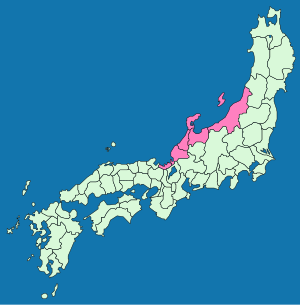Hokurikudō

Hokurikudō (
When the Gokishichidō system was initially established after the Taika reforms, it consisted of just two provinces: Wakasa and Koshi. During the reign of Emperor Temmu, Koshi was divided into three regions: Echizen, Etchū and Echigo and Sado Island was added as a fifth province. Later, Noto and Kaga were carved out of Echizen to form seven provinces in total.
The Hokuriku subregion of Chūbu region constitutes Hokurikudō region today.
See also
[edit]Notes
[edit]- ^ Deal, William E. (2005). Handbook to Life in Medieval and Early Modern Japan, p. 83.
- ^ Nussbaum, Louis-Frédéric. (2005). "Hokuriku" in Japan Encyclopedia, p. 344, p. 344, at Google Books.
- ^ Nussbaum, "Hokurikudō" in p. 345, p. 345, at Google Books
References
[edit]- Nussbaum, Louis-Frédéric and Käthe Roth. (2005). Japan encyclopedia. Cambridge: Harvard University Press. ISBN 978-0-674-01753-5; OCLC 58053128
